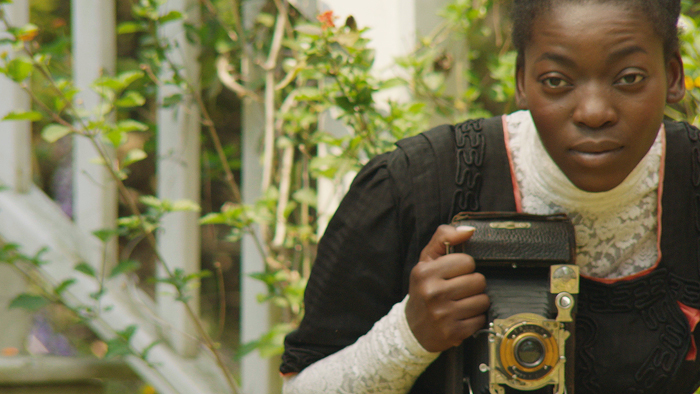Erika Balsom zooms in on artists who interrogate the violent history of documentary cinema
The kinship between the camera and the gun goes back a long way. In 1882 Étienne-Jules Marey took aim with his fusil photographique, producing chronophotographic studies of birds in flight. In their 1969 manifesto Towards a Third Cinema, Argentine filmmakers Fernando Solanas and Octavio Getino described their anti-imperialist practice as ‘a long war, with the camera as our rifle’.
The association is not always affirmative. The history of documentary cinema is, among other things, a history of domination and objectification in which the camera has served as an instrument of violence. The moving image was an integral part of the colonial project, leaving filmmakers with the task of reckoning with this inheritance. When does shooting (as in wounding) meet ways with shooting (as in filming)? When does the urge to make something visible meet ways with exploitation? As a growing number of contemporary artists turn to picturing marginalised subjects and histories of oppression, such questions push to the fore. There is no magic formula that allows them to avoid this trap – but a handful of recent works led me to consider how obliquity and omission can work as strategies to transform the camera-gun into a tool that honours and repairs.
Madeleine Hunt-Ehrlich’s Spit on the Broom (2019) is the product of the artist’s research into the history of the United Order of Tents, a clandestine society of black women in the United States that has been operating continuously since the time of the Underground Railroad. Given that the order’s activities and customs have necessarily remained secret, Hunt-Ehrlich’s subject is in inherent tension with documentary’s predilection for exposure. The critic Serge Daney proposed that ‘the highest function of cinema’ is that ‘it doesn’t prove, doesn’t privilege, it gives something to be seen’. Hunt-Ehrlich concurs, but suggests that it can equally abide by an ethics of opacity. Producing a metacommentary on the ambivalence of visibility, she turns to fragmentary news reports and images that evoke without explaining, reformulating experimental nonfiction as a practice of withholding as much as revelation.
It’s a lesson that was on my mind during this year’s edition of Forum Expanded at the Berlinale, the section of the film festival devoted to artists’ films, organised independently from the competition programmes by the Berlin-based Arsenal – Institute for Film and Video Art. It coloured my viewing of two otherwise very different films concerning indigenous life in the Amazon. At the start of Jíibie (2019), a work exploring the preparation and significance of the coca plant among the Witoto people of southeastern Colombia, Bogotá-born, Paris-based artist Laura Huertas Millán offers an immediate clarification through onscreen text: ‘This film is not about cocaine, white powder’. The relation to narcoviolence is present only through negation. Jíibie largely forgoes contextualising information in favour of a tactile immersion in the process of preparing the leaf. As Cristóbal Gómez Abel, the film’s principal protagonist, relays the origin story of mambe – the powder made from coca and ash – Huertas Millán films his mouth in extreme closeup, yoking speech to body. She creates a form that echoes the attitude she adopts towards her subject, favouring the partial and working with sensation more than information.

Ana Vaz’s film Apiyemiyekî? (2019) centres on an archive of drawings produced by the Waimiri-Atroari in Brazil as part of a literacy initiative undertaken by the educator and activist Egydio Schwade between 1985 and 1986, near the end of the military dictatorship. Here, as in Jíibie, formal experimentation serves to suggest how collective memory is transmitted through material practices, with the artist making no presumption to speak for indigenous people or explain their experience. Superimposed over black-and-white images of the landscape, the colourful drawings show fragmentary scenes of daily life lived under attack as the construction of a new highway aimed at facilitating resource-extraction turned into genocide. The present-day lives of the Waimiri-Atroari remain out of view. Beginning and ending her film with disorienting images of the capital city of Brasilia, Vaz summons the spectre of ongoing state violence without directly picturing it.
In grappling with histories of oppression and resilience, these artists leave much unsaid and unseen – acts that bear directly on how they address their audiences. In Apiyemiyekî? Schwade mentions following Paulo Freire’s methods from Pedagogy of the Oppressed (1968), a book that advocates for a ‘problem-posting’ model of education located in listening and dialogue, as opposed to a ‘banking’ model, whereby students are empty containers the teacher fills with knowledge. It struck me that these diverging pedagogies also resonate as two poles of how documentaries might inform their viewers: many lean towards banking, but not these artists. They pose unresolved problems, discarding any pretence to mastery, conveying an avowed partiality, leaving me to dwell in the uncertainty of the encounter.
Erika Balsom is a writer and lecturer in film studies and liberal arts at King’s College, London
From the April 2020 issue of ArtReview
